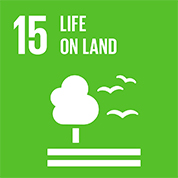Sustainable Development Goals
Goal 15: Life on Land
 The fifteenth Sustainable Development Goal is to protect, restore and promote sustainable use of terrestrial ecosystems, sustainably manage forests, combat desertification, and halt and reverse land degradation and halt biodiversity loss.
The fifteenth Sustainable Development Goal is to protect, restore and promote sustainable use of terrestrial ecosystems, sustainably manage forests, combat desertification, and halt and reverse land degradation and halt biodiversity loss.
We only have one planet, and we are proud to be working hard to protect it - ensuring we use it responsibly now, and conserve it for the future.
Teaching
26 modules have intended learning outcomes directly relating to this goal, and 1,640 students have the opportunity to choose these modules.
Research
99 articles relating to this goal were published in Scopus between 2018 and 2022, and 2,361 articles were 'cited by' in Scopus.
What we're doing (University activity)
Operational
On 4 July 2023, the University of Leicester Sustainability Team hosted a ‘Natural Entrepreneurs’ event, chaired by Professor Turi King, where young people captivated the audience with their innovative and considered ideas, inspired by biomimicry. These observations of natural concepts were then thoughtfully applied to projects which looked at the production of food in a world where space is at a premium, sustainable ventilation and insulation of buildings, housing adapted to survive flooding and rising sea levels, and more efficient travel.
The Future Students Office are embarking on a new initiative for the 2023/24 academic year and beyond. Every group of visiting prospective students will take part in a planting activity with the grounds and gardens team to plant a wild, native plant on the patch outside of the Bennet Building which offers a chance to engage with students about the importance of biodiversity on our campus.
Teaching
Global Change Biology and Conservation in Biological Sciences (BS2059) covers the major threats to global biodiversity including habitat loss, invasive species, over-exploitation and climate change. Students use fieldwork to demonstrate how conservation management can ameliorate the threats to important UK habits.
Research
Experts who are revolutionising agricultural practices have joined forces with Leicester scientists to develop a monitoring tool that tracks the environmental outcome of land management. The scientists are now in the process of finalising a prototype that can evaluate arable farms in Hertfordshire.
Courses that feature modules relating to this goal
Life Sciences
Biological Sciences
- Biological Sciences BSc
- Biological Sciences MBiolSci
- Biological Sciences (Biochemistry) BSc
- Biological Sciences (Biochemistry) MBiolSci
- Biological Sciences (Genetics) BSc
- Biological Sciences (Genetics) MBiolSci
- Biological Sciences (Microbiology) BSc
- Biological Sciences (Microbiology) MBiolSci
- Biological Sciences (Neuroscience) BSc
- Biological Sciences (Neuroscience) MBiolSci
- Biological Sciences (Physiology with Pharmacology) BSc
- Biological Sciences (Physiology with Pharmacology) MBiolSci
- Biological Sciences (Zoology) BSc
- Medical Biochemistry BSc
- Medical Biochemistry MBiolSci
- Medical Genetics BSc
- Medical Genetics MBiolSci
- Medical Microbiology BSc
- Medical Microbiology MBiolSci
- Medical Physiology MBiolSci